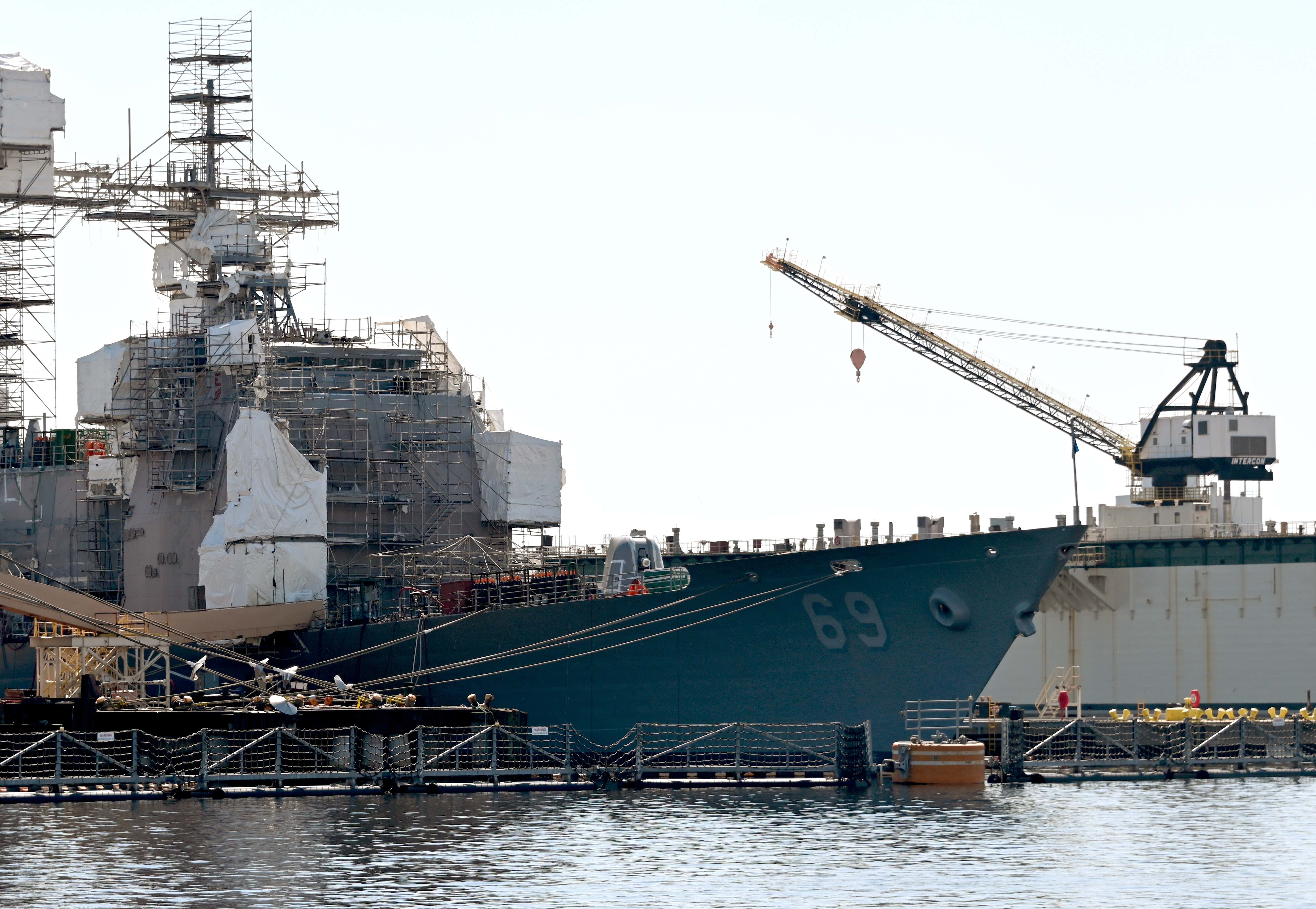
A Ticonderoga-class guided-missile cruiser the Navy wants to decommission next year is nearly finished with a modernization overhaul that costs hundreds of millions of dollars, a service official told lawmakers today.
USS Vicksburg (CG-69) is about 85 percent of the way through the cruiser modernization program meant to extend the life of the ship.
“The cruiser Vicksburg, I think, is in that 85 percent range,” Jay Stefany, the principal civilian deputy to the assistant secretary of the Navy for research, development and acquisition, told the House Armed Services seapower and projection forces subcommittee on Wednesday.
Whidbey Island-class dock landing ship USS Tortuga (LSD-46) – which is also undergoing upgrades to extend the ship’s service life – is at a similar stage in its modernization, according to Stefany. He confirmed the Navy has spent close to $300 million to upgrade each ship.
Vicksburg and Tortuga are two of the 24 ships the Navy wants to decommission as part of its Fiscal Year 2023 budget proposal. Both ships are undergoing their modernization programs at BAE Systems Ship Repair in Norfolk, Va.
Asked last month for the completion percentage of the two ships, a spokesperson for Naval Sea Systems Command said the Navy does not track these figures. The spokesperson said Vicksburg is slated to finish its modernization overhaul in the summer of 2023, but that the completion date for Tortuga “is under review.”
The recent budget request, which also proposed decommissioning every Freedom-class LCS currently in service, has met criticism from lawmakers who are unhappy that the Navy is decommissioning more ships in a year than it plans to buy.
During a separate House Appropriations defense subcommittee hearing on Wednesday, Rep. Kay Granger (R-Texas) criticized the Navy for how it has used taxpayer funds. Granger, the ranking member of the House Appropriations Committee, said the service in the last two years has spent almost $500 million to modernize Vicksburg.
“Some of these ships – especially the Littoral Combat Ships – are among the newest in the fleet. The Navy claims they don’t have enough sufficient funding to maintain and operate these ships, but that’s not the case. Instead, they’ve mismanaged billions of dollars in maintenance funding. One glaring example of this is the USS Vicksburg, a cruiser up for decommissioning this year,” Granger said.
“Since 2020, the Navy has awarded nearly $500 million in contracts to upgrade the cruiser. At a time when the ship is still in its maintenance period, the Navy is proposing to scrap it. If the Navy experts expect Congress to support its vision for this fleet, it must do a much better job of managing the inventory it has. We will not stand idly by as valuable taxpayer funds are wasted.”
Navy officials have repeatedly argued the money would be better spent on modernization efforts than on extending the life of the aging cruisers. During the March budget rollout, Navy deputy assistant secretary for budget Rear Adm. John Gumbleton said decommissioning the proposed 24 ships in the FY 2023 budget would save the service $3.6 billion across the Pentagon’s five-year budget outlook.
Seeking to justify the proposal before defense appropriators today, Chief of Naval Operations Adm. Mike Gilday said both the LCS and the cruisers would not stand up well in a potential conflict against Russia or China.
“We took a look at our topline and we took a look at a Navy that we can sustain, a Navy that we can afford. But to make it the most lethal, capable, ready navy that we can – in other words, we’re trying to field the most lethal, capable, ready Navy we can based on the budget that we have rather than a larger Navy that’s less capable, less lethal and less ready,” Gilday told lawmakers.
“So we stratified our warfighting platforms. An LCS fell at the bottom of that stratification, along with the older cruisers that have an older radar, that have leaks below the waterline, radars that can’t detect these new Chinese threats, as an example.”
The FY 2023 proposal wants to decommission nine Freedom-class LCS and axes the planned anti-submarine warfare mission package originally slated for both variants in the class.
“Much of the testing done on that module was done on LCS-3, the Fort Worth, that helped us make the determination that we should not put another dollar against that system because it wouldn’t pan out against high-end Chinese and Russian threats,” Gilday said of the ASW mission module testing. Granger was the sponsor for USS Fort Worth (LCS-3).
“So regrettably we made tough decisions in this budget proposal to decommission, or propose to decommission, ships that just wouldn’t have added value to the fight,” Gilday said. “At the same time, we’re taking that money and investing it in our priorities, which are readiness, modernization, and then capacity at an affordable rate.”
Granger expressed her skepticism about the Navy’s plans for the LCS.
“Each one of these ships has significant useful service life left. One of them … was just commissioned in August of 2020. I don’t know how we can have confidence in your request when just a few years ago at this same hearing, the Navy advocated for LCS funding with the same passion you’re now expressing to get rid of them,” she said.





